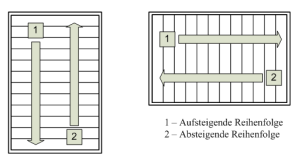Equippable component types
|
The component types of the categories “Network element”, “Card/Module”, “Container/Cabinet”, “Shaft” and “Duct/Route” are component types into which elements can be integrated. For this reason, these are summarised as equippable component types in the following section. The terms and characteristics explained below are hence used for all these component types.
|
Series/Segments Slots/Ducts |
In a equippable component type, component types can be placed in slots/ducts (Duct), which are configured in rows/segments (Duct) on a maximum of 2 levels. Slots can be given any name.
|
Levels |
The 2 levels on which the rows and slots are located are designated as: •1st Level: Card layer •2nd Level: Backplane layer The level subdivision has an impact on the component level; see Chapter “Components”.
|
Orientation |
The subdivision into slots/ducts per row/segment defines the graphical representation of the aggregate component types. The user can still additionally define whether they should have a horizontal or vertical orientation.
|
Numbering method |
Besides the orientation, the user can still specify whether the first slot should be positioned at the beginning or the end of the row: •01…10: •10…01:
|
Control function |
Various additional control functions are available for aggregate component types: •Useful slot utilisation •Only defined component types •Maximum number for each component type •Static component type •Automatic generation template
|
Slot utilisation |
The slot utilisation function indicates how many slots/ducts are contained in a component type. If the slot utilisation function is deactivated, each component type can only include one useful slot. Example: A cabinet is defined with 42 slots. This cabinet is to include a patch panel requiring 2 of these 42 slots. In this case, the slot utilisation of this patch panel is 2. If these 2 related slots are not available, equipment with another patch panel is prevented.
|
Only defined component types |
In the case of a equippable component type, the user can specify a list of component types that may be included in it. These component types are designated as element types, and for component types of the category “Network element”, as card/module types. If the control function “only defined component types” is activated, only the element type/card types are available for positioning.
|
Maximum number for each component type |
A maximum number can be defined for each element type/card type. This number specifies the maximum number of component types of this element type/card type that may be included in the container. Example: An element type “Strip type” of category “Strip/Panel” is allocated the maximum number 2. In the container/cabinet, the “strip type” can then be placed in 2 positions. This means that the maximum number is reached, and the “strip type“may not be equipped a third time.
|
Static component type |
If a component type is defined as static, it means that when a component of this type is generated, components within the component type are created in the background according to the equipment template. These components included in the component are fixed; the user may neither add new ones, remove any, nor change their position. Only names may be changed.
|
Automatic generation |
It is possible to define in which slots which component type is placed (several slots can be used) in the equipment template. If a component type is created automatically, components of exactly this component type can be generated in the slots according to the equipment template.
|
|
Example: The following generation template is defined for a component type “Container type” with 6 useful slots: •Useful slot 1: Component type “Strip type” with slot utilisation 1 •Useful slot 2: Component type “Terminal type“ with slot utilisation 3 (“Terminal type” located in useful slot 2,3,4) •Useful slot 5: Component type “End device type“ with slot utilisation 2 (“End device type” located in useful slot 5,6) If a component of component type “Container” type is created, the 3 following components are jointly created: •Component type “Strip type“ on Slot 1 •Component “Terminal type” on Slot 2-4 •Component “Final device type” on Slot 5-6
|

